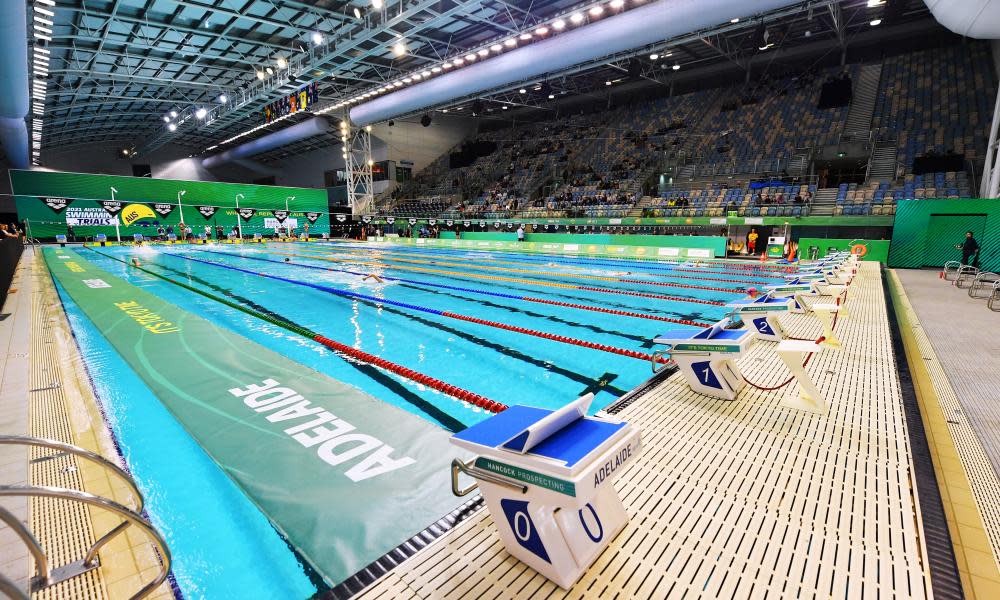Quality over quantity as Australia’s swimmers build towards Tokyo

Spare a thought for Zac Stubblety-Cook. At the Olympic trials on Saturday, the 22-year-old won the men’s 100-metre breaststroke, touching the wall at the State Aquatics Centre in Adelaide in a time of 59.69 seconds. He finished a quarter of a second inside the qualifying time required by Fina, the sport’s global governing body, to earn a place at the 2021 Olympics. But unless Stubblety-Cook can qualify in another event, he will not be on the plane to Tokyo next month – because Swimming Australia set a more exacting qualifying standard, at 59.21 seconds.
Stubblety-Cook is not the only Australian to fall short over the weekend. Brianna Throssell touched home second in the women’s 100-metre butterfly in the first final of the meet, behind only four-time world champion Emma McKeon. Australia can take two swimmers per discipline to the Games. But Throssell, despite besting the Fina qualifying time by almost a second, fell an agonising one-hundredth of a second short of Swimming Australia’s standard. No ticket to Tokyo (although she may qualify for the 200-metre butterfly on Tuesday).
Related: Swimming in problems? Maddie Groves allegations overshadow Olympic trials
The stance taken by the domestic peak body means that Australia will take a much smaller team to Japan than it could under Fina rules (which permit a maximum of 52 athletes per nation). But in each discipline where an Australian swimmer does qualify, they will be right on the pace. Swimming Australia’s qualifying standard was based on the eighth-fastest qualifying time at the last world championships, held in South Korea in 2019. In other words, every Australian swimmer at the Olympics will be expected to reach their final.
This philosophy – quality over quantity – marks a shift for Swimming Australia. The qualifying times for the 2016 Olympics were considerably slower: Stubblety-Cook would have breezed past the 59.75-second time required for Rio, while Throssell would have been almost a second within the qualifying standard. At the time, news outlet SwimSwam noted that Australia times were “considerably slower” than those of rival nations.
After relative disappointment in Rio – Australia managed just three gold medals in the pool – this change is one of several levers being tilted in the hope that swimmers will be propelled to faster times and more medals in Tokyo. As one long-time observer noted from the pool deck on Sunday: “We’re not just sending people to swim laps.” Swimming Australia declined to comment on the revised selection change.

But the hard-done-by feeling swung both ways over the weekend. Just as events went by without a single Australian qualifying for Tokyo, in other disciplines three or more swimmers recorded the necessary time – but for those outside the top two, their Olympic hopes are now over. The cruelty was particularly acute in the blue-riband men’s 400-metre freestyle, where the top five finishers all swum inside the 3:46.34 standard.
Reigning Olympic champion Mack Horton, plus youngsters Thomas Neill and Sam Short, could only watch on in despair as Elijah Winnington and Jack McLoughlin booked the two available spots. Such was the pace in the pool in Adelaide that Horton’s time, which was not enough to send him to Tokyo, would have placed him in the top five at the 2019 world championships.
All of which means that Australia will send a lean but mean Dolphins team to the Olympics next month. Winnington’s time was the fastest 400-metres in the world this year – even if reigning champion Sun Yang can overturn his doping ban, Winnington will be the man to beat in Tokyo. McKeon’s 100-metre butterfly time, meanwhile, was the second fastest swum anywhere this year (bettered only by China’s Zhang Yufei).
Australia’s medal potential in Tokyo was underscored on Sunday during day two of the trials (which conclude on Thursday). Nineteen-year-old Kaylee McKeown broke the world record in 100-metre backstroke, throwing down the gauntlet to North American rivals Regan Smith and Kylie Masse. In the 400-metre freestyle, Ariarne Titmus continued her recovery from a shoulder injury with a new personal best, the second fastest time in history, in an impressive show of form ahead of her Tokyo showdown with reigning Olympic champion Katie Ledecky. “She’s not going to have it all her own way, I guess,” Titmus said.
Related: Swimming Australia ‘very concerned’ by Maddie Groves withdrawal over ‘perverts’
Veteran Emily Seebohm became only the second Australian swimmer to qualify for a fourth Olympics, but her post-swim comments raised eyebrows as Swimming Australia grapple with allegations that it has a culture problem. “A lot of people said that I wasn’t going to do it,” said Seebohm, in tears, after the race. “I was too old, I needed to lose weight, I needed to look different, I guess I just stuck to my guns.”
The 29-year-old won gold in Beijing, gold and two silver medals in London and silver in Rio, but failed to make the team for the last world championships in 2019. “Two years ago I didn’t feel comfortable in my togs,” Seebohm added. “To be here and feel comfortable again, to race happy again, is such a blessing.”
Concerns over team culture, sparked by Maddie Groves’ withdrawal from the trials last week, seem set to linger over Swimming Australia in the weeks ahead. But in the pool, Australia’s swimmers are quietly building towards a medal-laden Olympics following the disappointment of 2016. After smashing the world record on Sunday night, teenage prodigy McKeown was asked whether Australian swimming was back. “I think it is,” she said. “It never really left.”

 Yahoo Movies
Yahoo Movies 
